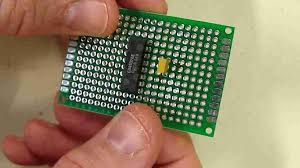For efficient PCB production, DFM (Design for Manufacturability) helps you optimise design so as to minimise errors, control costs and expedite the manufacturing process. Engineers can use DFM to pin-point any potential manufacturing issues early in the design phase, allowing for a 30% production cost savings by preventing costly redesigns and rework. DFM is important in fast-paced industries with tight budgets and timelines to ensure projects limit scope and stay on schedule.
Trace width and spacing is an important area where DFM enhances efficiency. For traditional PCBs, traces have to fulfill minimum width requirements of at least 0.1mm for signal traces (or more for power). These guidelines help designers to prevent problems such as trace lift-off and short circuit failure due to traces being too small or close together. This type of DFM checks ensures that the traces will withstand during manufacturing and act safely without failure post-assembly.
Edition also has the important role in DFM with hole sizing and placement. Especially in multilayer, high-layer PCBs, when the vias are configured with incorrect dimensions/positioning it can lead to cracks or breakage and weaken the overall structure of the board. For regular boards, they are typically 0.3mm in diameter but can go as small as 0.1mm with a high rigidity interconnect (HDI). DFM standards verify that all of the vias on a board fall within size and location specifications (such as the pad size in relation to too much conduction area), which is essential for producing reliable electrical connection in smaller, densely dense designs.

DFM also comes into play regarding solder mask clearance and pad design. Solder masks also aid in controlling solder flow and preventing solder bridging between pads which is commonly seen with fine-pitch components where pads are often placed as close as 0.2mm from one another. Screen printing aside, solder mask clearance and thickness are also adjusted according to DFM guidelines as a way for manufacturers to control defects during assembly, which leads to enhanced yield rates and reduced costs related with rework.
DFM copper balance is another critical element for efficient PCB manufacturing. If the PCB has more than four layers or one side is heavily loaded with copper, an unbalanced copper distribution can cause warpage. Warping is a leading cause of misalignment, creating defects that are expensive and time-consuming to fix. Distributing copper evenly mitigates the risk of warping due to thermal manipulation and reduces issues during production, which can be an advantage when implementing DFM principles.
According to industry consultant Dennis Fritz, “DFM saves money not only in fabrication but in every stage of assembly and testing.” This view emphasises that one of the best ways to lower cost and improve quality is to apply DFM early in design. PCB designs that fit not just functionally but also allow for DFM (which is, exactly the point of DFM) are key to getting efficient PCB production with both high performance and time-to-market.
With the adoption of pcb dfm, quicker production cycles, lesser errors, and higher productivity can be expected from manufacturers. Since DFM-driven designs are based on manufacturing capabilities and end-user expectations, they are of superior quality and reliability. In the end, DFM is foundation of cost efficient and high quality PCB manufacturers it a fundamental approach to manufacturing in today ever more technology-oriented world
